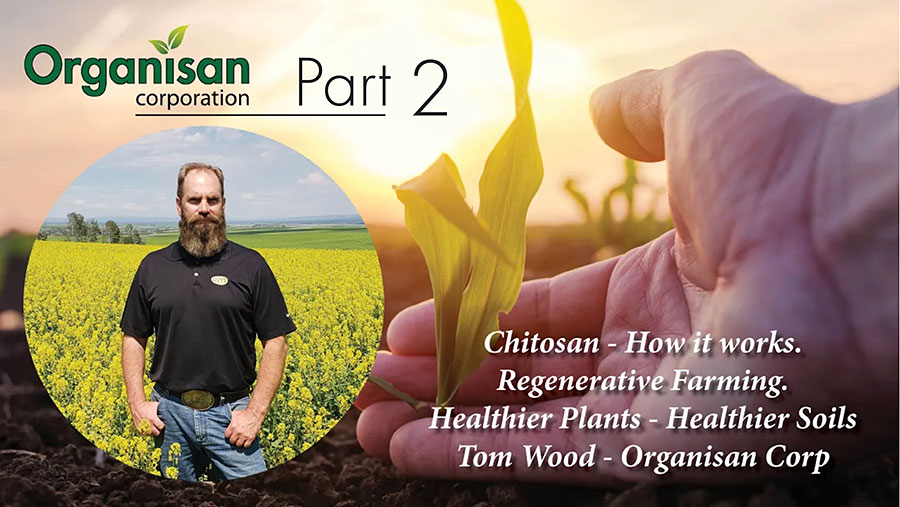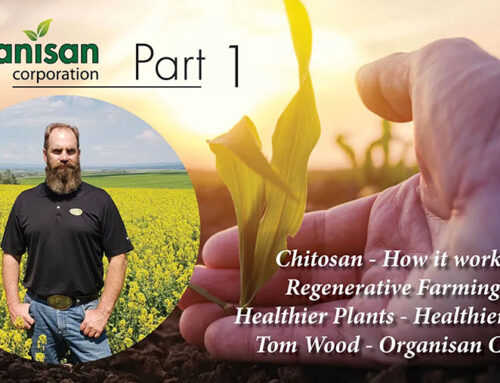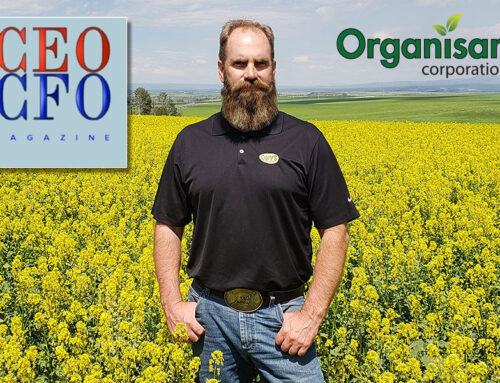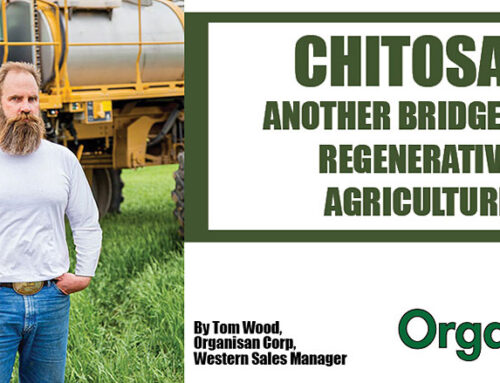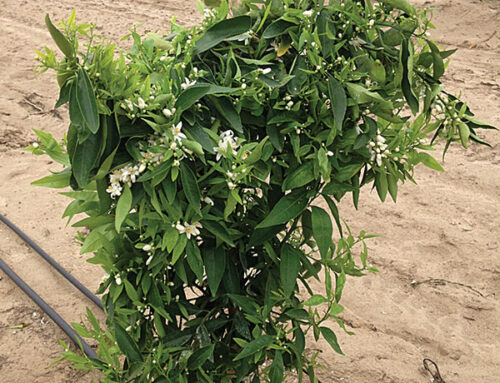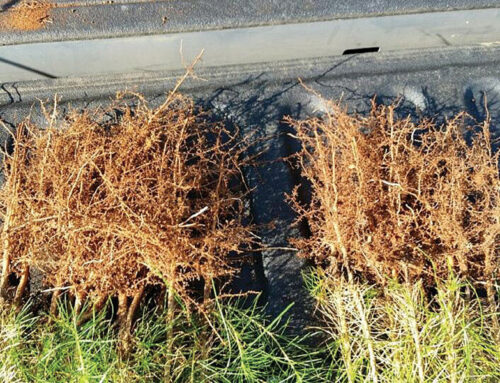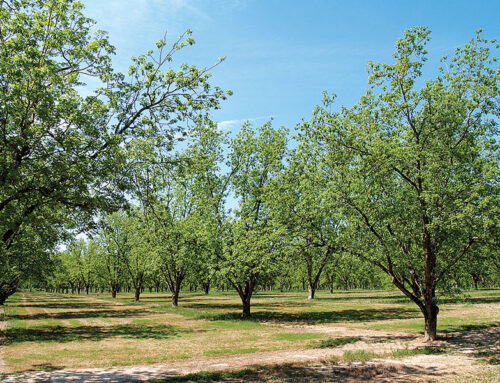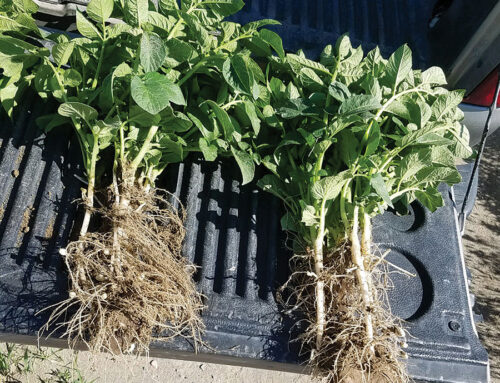Breaking Down the Many Functions of Chitosan with Tom Woods
In Part 2 of this series, Tom Wood, Western territory manager at Organisan, delves into the science behind some specific functions of Organisan’s signature agricultural product, Chitosan.
Tom, I’d like to build on our first conversation about the history of the product, Chitosan, its origins, and how you found it by delving into its various functional properties in commercial agriculture.
I’ve explained that Chitosan is a refined form of chitin, the second most common polymer in the universe – behind cellulose. Everything in nature with an exoskeleton, like shellfish, one example, contains chitin in its construction. The refining process makes chitin more predictable, bio-available, and readily available in the environment.
Let’s go a little deeper into Chitin’s makeup. The enzyme that chitin produces is called chitinase. In nature, like in the human body, enzymes tear things apart and put things together. In this case, chitinase tears apart chitin and chitosan. This is where the magic happens, as they say, in this chitinase production. We need a microbial community to get the full benefit from chitinase production in the full range of the functions of Chitosan.
Okay, let’s start with Chitosan as a fungicide.
Well, the first thing we do is trigger the SAR SIR — substrate-induced respiration. We trip that receptor on the plant leaf and get this plant’s self-defense mechanisms moving up. This works to permeate the cell structure of fungi.
It’s interesting to note here that just about down the line between what we call a pathogen and what we call a beneficial, the good Lord and Mother Nature made a distinction between the amount of chitin that’s in the cell wall construction between these organisms, and the cell permeability, or how wet it is inside this cell. Chitinase is very effective at tearing apart the chitin construction in the pathogens’ cell walls, allowing chitin to become a food source for the beneficial microbes. In other words, we give them [beneficial microbes] something to eat and a job to do — produce chitinase. They know what to do when in the presence of chitin and chitosan. It’s an instinctual characteristic; nobody told them to pack a lunch and gave them an assignment at the mine today. They are programmed by nature.
Trichoderma harzianum is one of the most prolific chitinase producers that scientists have identified within the fungal realm. Beauveria bassiana is an easy one to deal with; this is a hearty spore former that survives through application processes, and what bassiana brings to the table is this: If you start with one organism — this gets into a little bit of the prescriptive microorganisms if you will — but this microorganism is right up there at the top of my top of the list. When we supply the bassiana with chitosan as a food source, it functions as a bactericide. You might have to believe the unbelievable with this combination.
I’m ready. What happens?
When we trigger the SAR SIR response, there’s an attraction that’ll happen between the pathogenic fungi having that chitin construction within them, the old chitin mother parent material inside there meets the chitosan that we spray on it, there’s an attraction that happens through the cell wall membrane. They try to come back together. That pulling action tears at the inner cell membrane, and that pathogen will actually bleed out — known as cell lysis. This is slower than the fungicidal process but effective because it interferes with the bacteria’s ability to divide fully. The interference prevents a new cell from forming completely, so the “half-complete” cell dies off fairly quickly.
Let’s talk about Chitosan as a virucide.
As we’ve all learned from the COVID-19 virus, viruses are trickier to control or eliminate. For example, simple cold sores are caused by a virus, and the remedy is a topical ointment that shortens its duration — but it doesn’t kill the virus itself or eliminate it from your system. However, in the 1960s, research showed that zinc denatures the protein coat of viruses. But we don’t hear anything about topical zinc applications for plants.
So, the way Chitosan functions as a virucide is that, once again, it comes down to prevention. When Chitosan is applied, it triggers the SAR-SIR response, meaning the plant is already cranking up when a virus shows up. There’s no delay or lag — we aren’t trying to catch up. We are already full bore when a virus shows up, which is a big deal for Idaho potato production. I’m right on the cusp, in fact, in Eastern Idaho. If you go east of me a few miles, it’s seed production from there to the Wyoming state line. But everything west and south is all commercial production.
Is there an example of a potato virus situation you can share?
Potato virus Y (PVY) is an enormous problem in potato seed production. We can do a lot to help with things like wheat streak mosaic. I have a story to illustrate. About four or five years ago, we had a potato seed farmer, and to make a long story short, he was desperate; he had nothing left to lose when he heard about us. He was going to be put out of the seed production business.
They were down to one small pivot — that’s all they were doing. We came in and split the pivot in half. We kept the grower standards the same on the entire pivot. On one half of it, we put down one pint per acre of O2IS through the airplane. Then we did that again 21 days later.
Those potatoes were then sent to Hawaii by Idaho crop improvement for the grow-outs. When the results came back, the PVY number of the untreated side had gotten so big that crop improvement would not tag those for seed. They had to go to the warehouse. But on the side that we treated, the PVY number, depending on the farm manager or the farm agronomist’s data, either stayed the same as the generation they planted or went down slightly from the generation they planted.
I can tell you that never happens. With PVY, all you can do is try to slow the burn. You’ll never reverse it. — you can’t. Anyone who has ever dealt with it will tell you that all you can do is try to slow the burn. And we stopped the burn.
So that was four or five years ago. How is the farm doing now?
Very well. That farm has remained a very loyal user.
Ok, Tom. Next up: Nematicide.
Ahh, nematicide. It’s one of my favorite properties to talk about. I’ll start at the end and work my way back. Chitosan is so effective as a nematicide we have been granted and have an EPA-registered nematode product called Nemesan. Trust me, EPA doesn’t just hand these puppies out just because you put in an application form and write “please” at the bottom.
Once again, we trigger the SAR SIR response. The chitin/chitosan exposure to these microbes triggers the chitinase enzyme expression, breaking down the chitin and chitosan it finds.
If you look under a microscope at a nematode, you will see what kind of looks like a horn or stick at one end; that’s actually a stylet tooth they use to penetrate. That tooth is made of chitin. So, chitinase starts to degrade the mouth parts and, in some cases, the esophageal tract of many of these nematodes.
My favorite class of nematodes to go after is anything with ‘cyst’ in the name. One is called the cereal cyst nematode, an issue for cereal grain production in Idaho. Another is the soybean cyst nematode. With this one, when the female reaches sexual maturity, she will contain 200 – 500 eggs. Toward the end of her lifespan, she basically turns into a chitin cyst and encompasses all of the eggs within her. We’ve wiped out an entire generation with one microscopic pinhole through that cyst.
I will tell you that when it comes to understanding Chitosan as a nematicide, I was helped by a nematologist I met at a conference not long after we were starting to make some serious headway in this product’s function as a nematicide. He explained to me this all has to do with the egg lays.
If the nematodes lay eggs in a line, we can easily affect those individual eggs. In particular, nematodes lay eggs in a cluster or pile when we get into the root knots. Now, we have to constantly burn through this pile of eggs with our chitinase enzyme. So, through our field experience, we can now tell what is happening with the egg lays and how to attack.
When you look at a field’s assay report, for example, you know how you need to adjust the chitinase application?
Yes. With the assay, we can see what nematodes are present; are they spiral, stunt, dagger, etc. Based on what nematodes are pestering you, additions can be used, such as fulvic acid, which has shown to be a big help in increasing the efficacy of chitinase.
But with nematode control, you have to look for it. If you tell me that you don’t have soybean cyst nematodes, show me your assay that says specifically you don’t. Have you ever looked for soybean cyst nematodes? Maybe that’s why you think you don’t have them.
This sounds like a good place for an example…
It is. I would encourage everybody in the soybean production side of agriculture to do a nematode assay. One of my quick cheats, as I call them, is white mold; white mold is always a concern for soybeans. Is sclerotinia a concern for you? Is botrytis a concern for you? I mentioned earlier that there’s an interconnection between many of these microbes in that a solution for one thing over here caused another problem over there. This is one of these situations. It’s where the preventative characteristics of Chitosan are so valuable.
Sclerotinia, or anything that survives in a sclerotia form in the soil, particularly in the off-season, should interest you. Guess what sclerotinia is composed of? Chitin. So we can be treating for nematodes, and we’re actually having a significant effect on overall plant health because we’re reducing that sclerotia in the soil.
If you wait until white mold is ravaging your field, we can help with that, but again, you could be focused on prevention versus cure. As we all know, an ounce of prevention is much easier and, in this case, less expensive than a pound of cure.
We’ve seen this start to occur in Idaho now; we’re hypersensitive to the nematode populations with potatoes because they’re affecting what we need to sell. So the first unsightly bump shows up, and you can’t have that.
It sounds like you’re coming back to one of your original points about holistic farm management, Tom.
Yes. There’s an area in Eastern Idaho where the tobacco rattle virus is a real threat to potato farms. If it takes hold, the tobacco rattle virus causes a condition called corky ring spot. Commercial potato farmers are allowed up to 2% corky ring spot in their samples to be able to move them on the market. If there’s more than that, processors won’t even take them because it will cause unsightly rings and dark spots in your potatoes when you try to fry or chip them.
So we see situations with farmers where they start treating the nematodes. Eventually, they move into the fumigation, which works for a while. Then, they move into heavier, higher rates of fumigation. After a few fumigations, suddenly, they have to spray for the white mold problem that’s developed. And they’ve never had to spray for that before. So they went from spraying nothing last year to now three applications of Endura to combat the white mold problem. This is a prime example of reductionist agriculture versus wholistic. Your solution for one problem leads to your next problem.
Tom, we’ve covered a lot of ground. You’ve explained Chitosan’s functions as a fungicide, bactericide, insecticide, and nematicide. The next step in our discussion of Chitosan gets into the metabolic reactions of the plants.
Yes, Chitosan affects plant metabolism in so many different aspects. Absolutely. I look forward to that conversation.
Thank you, Tom.
In Part 3 of our conversation about this remarkable application, Chitosan, Tom walks us through the product and its functions as a plant elicitor, microbial stimulant, nutrient and mineral chelator, and more. (Chitosan: How It Works with Tom Wood – Part 3)

